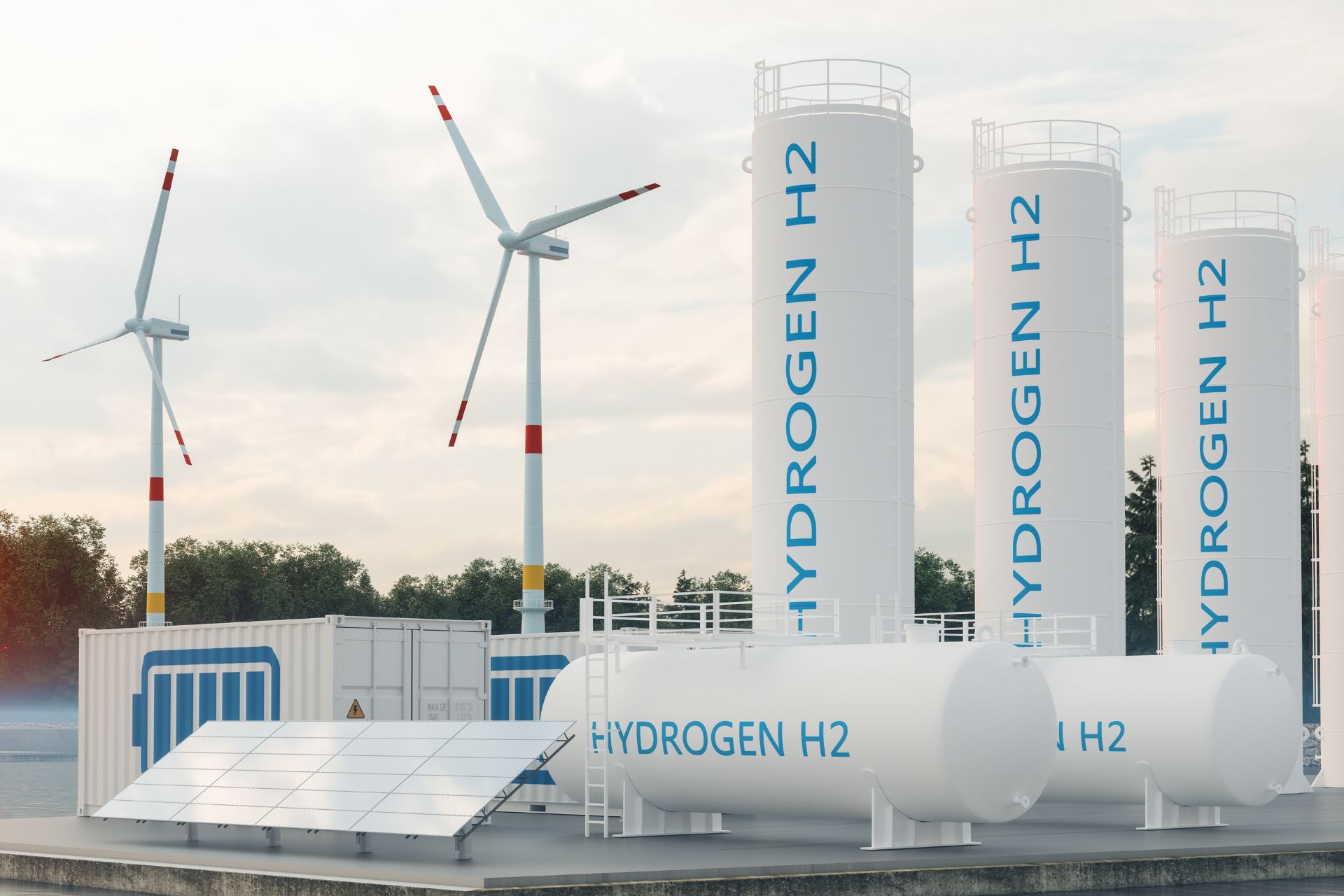A domestic market for clean hydrogen is central to achieving the Biden administration’s goal of a 100 percent clean electrical grid by 2035 and net-zero carbon emissions by 2050. The U.S. has made extraordinary progress toward developing and implementing the National Clean Hydrogen Strategy and Roadmap in a few short years.
With strong leadership from the Department of Energy (DOE), the U.S. has moved from concept to appropriation, public-private planning, and interagency coordination, and more recently toward selection, funding and construction of regional clean hydrogen hubs (H2Hubs) that will be the key drivers for growth of the clean hydrogen market.
The success of the H2Hub program, and the availability of private funding on top of the program’s $8 billion federal investment, will depend on the terms for the 2022 Inflation Reduction Act’s Section 45V Clean Hydrogen Production Tax Credit. Section 45V gives qualified projects that begin construction before 2033 a tax credit for 10 years after startup, with up to a $3 credit per kilogram. The long-awaited related proposed rule was belatedly issued by the Treasury Department and Internal Revenue Service (IRS) on Dec. 22. 2023, and immediately became a lightning rod for comments by industry, environmental organizations and politicians on how green and clean hydrogen production has to be to qualify for the maximum Section 45V credit.
While the debate rages over the proposed rule for Section 45V hydrogen production tax credits, the DOE has not slowed its efforts to further the U.S.’ Big Bet on Hydrogen. The DOE has continued to invest heavily in the research and development of technology to support the seven selected hydrogen hubs and has taken concrete steps to develop demand side support measures to facilitate purchases of clean hydrogen. The DOE also has continued to reach out to educate and hear from public about the H2Hubs. As these efforts converge towards the realization of clean hydrogen hubs, they highlight the synergistic potential of public and private partnerships in driving the nation toward its clean energy and climate objectives, setting a precedent for global energy policy and action.
$750 Million More to Support America’s Growing Hydrogen Industry
On March 14, 2024, the DOE announced $750 million funding for 52 projects across 24 states to advance electrolysis technologies and improve manufacturing and recycling capabilities for clean hydrogen systems and components.
These projects are managed by the DOE’s Hydrogen and Fuel Cell Technologies Office (HFTO). They are being funded through the Bipartisan Infrastructure Law (BIL), which authorized $1 billion for research, development, demonstration, and deployment activities to reduce the cost of clean hydrogen produced via electrolysis and $500 million for improved processes and technologies for manufacturing and recycling clean hydrogen systems and materials.
These projects will provide critical support for the long-term viability of the seven H2Hubs that are being funded by $8 billion from the BIL by helping solve the technical barriers to achievement of cost reduction goals. The focus of many of these projects on electrolyzers should advance the development and implementation of lower cost technologies for those hubs to produce green hydrogen and distribute it to users.
The selected projects fall into six topic areas, which directly support the National Clean Hydrogen Strategy:
- Low-Cost, High-Throughput Electrolyzer Manufacturing (eight projects, $316 million): These projects were selected to conduct research, development and demonstration (RD&D) to enable greater economies of scale through manufacturing innovations. Approaches to be considered include automated manufacturing processes; design for processability and scale-up; quality control methods to maintain electrolyzer performance and durability; reduced critical mineral loadings; and design for end-of-life recovery and recyclability.
- Electrolyzer Component and Supply Chain Development (10 projects, $81 million): Selected projects will support the U.S. supply chain manufacturing and development needs of key electrolyzer components, including catalysts, membranes, and porous transport layers.
- Advanced Technology and Component Development (18 projects, $72 million): Selected projects will demonstrate novel materials, components, and designs for electrolyzers that meet performance, lifetime, and cost metrics – to enable cost reductions and mitigate supply chain risks. Longer-term cost reductions enabled by these cutting-edge projects are likely to play a significant role in achieving DOE’s Hydrogen Shot goal.
- Advanced Manufacturing of Fuel Cell Assemblies and Stacks (five projects, $150 million): Selected projects will support high-throughput manufacturing of low-cost fuel cells in the U.S. by conducting RD&D to enable diverse fuel cell manufacturer and supplier teams to flexibly address scale-up challenges and achieve economies of scale.
- Fuel Cell Supply Chain Development (10 projects, $82 million): These projects will conduct R&D to address critical deficiencies in the domestic supply chain for fuel cell materials and components and develop advanced technologies that reduce or eliminate the need for per- and polyfluoroalkyl substances (PFAS), often referred to as “forever chemicals.”
- Recovery and Recycling Consortium (1 project, $50 million): This funding establishes a consortium of industry, academia, and national labs to develop innovative and practical approaches to enable the recovery, recycling, and reuse of clean hydrogen materials and components. The goal of this project is to establish an industry blueprint for recycling, securing long-term supply chain security and environmental sustainability.
Including recipient funding, the total investment in these projects is expected to exceed $1.6 billion, and produce more than 1,500 new direct jobs and thousands of indirect ones. In furtherance of the administration’s Justice40 Initiative, the selected projects are anticipated to support workforce development, energy equity, and diversity, equity, inclusion, and accessibility initiatives in disadvantaged communities. They include engagement with more than 40 community partners to facilitate community-focused activities such as community advisory boards, improvements to local transportation, and local impact analyses.
The DOE estimates that these projects will enable production of enough fuel cells to power 50,000 medium- and heavy-duty trucks annually. The agency further expects that this multi-project support for domestic electrolyzer manufacturing will enable production of up to 10 GW of electrolyzers per year – which translates to adding 1.3 million metric tons of annual clean hydrogen production capacity. According to the DOE: “That’s enough growth in production – in just one year– to provide an annual supply of clean emissions-free fuel for nearly 170,000 long haul trucks.” If realized, these outcomes should help facilitate industry efforts to comply with the Environmental Protection Agency’s March 29 Phase 3 rule to reduce GHG emissions from heavy-duty vehicles.
To complement these projects, on March 25 the DOE also announced BIL funding to renew funding for the Roll-to-Roll (R2R) Consortium of national laboratories’ processes that will reduce the cost of manufacturing electrolyzers and fuel cells. The R2R Consortium is led by the National Renewable Energy Laboratory (NREL) and includes Argonne National Laboratory (ANL), Oak Ridge National Laboratory (ORNL), Lawrence Berkeley National Laboratory (LBNL), and Sandia National Laboratories (SNL). According to R2R director Scott Mauger: "Our overarching goal is to de-risk and accelerate U.S. manufacturing of high-performance, durable, and low-cost fuel cells and electrolyzers."
DOE Selects Consortium to Bridge Early Demand for Clean Hydrogen
In response to the potential economic obstacles to accepting clean hydrogen as an alternative fuel source by potential users, the administration announced on July 5, 2023, an additional $1 billion investment from the BIL funding to provide demand side support for producers and users of H2Hubs during the early years of clean hydrogen production. In parallel, the DOE collected information about demand side mechanisms and found there was substantial support for pay-for-difference or “market maker” in which the DOE makes up the gap between buyer willingness-to-pay and market-determined pricing, as well as for stacking those demand-side measures with tax incentives and cooperative agreements.
The DOE also received substantial support for using a single independent entity with a national scope to oversee and implement the H2Hubs. Following issuance of a request for proposals, on Jan. 17, 2024, the DOE selected a consortium comprising the EFI Foundation (EFIF), a leader in clean hydrogen economy development; the commodity markets information experts, S&P Global (S&P); and the financial exchange operator Intercontinental Exchange (ICE). According to DOE:
EFIF, S&P, and ICE will leverage their deep expertise in clean hydrogen, project finance, and commercial contracting to support design of measures to de-risk clean hydrogen projects and increase demand certainty. The consortium will help craft demand-side support agreements for clean hydrogen projects affiliated with the H2Hubs to unlock final investment decisions and catalyze the formation of a mature clean hydrogen market. Ultimately, the demand-side initiative will support the growth and sustainability of the H2Hubs program by providing improved offtake certainty to help hydrogen producers attract private sector investment and end-use buyers. It will also lay the foundation for broader private sector scale-up and use of the clean hydrogen market by providing price transparency and standardized contracts for the projects it supports.
It is anticipated that over the next year the consortium will work with the DOE to “design robust demand-side support measures that will facilitate purchases of clean hydrogen produced by H2Hub-affiliated projects.”
Listening Sessions on Each of the Hydrogen Hubs Continue
At the time the seven H2Hubs were selected on Oct. 13, 2023, DOE committed that local stakeholders would have multiple substantive opportunities to engage with both DOE and the H2Hub projects, throughout the lifecycle of each project. Briefings have been provided on H2Hubs’ environmental justice and national labor and workforce matters. The DOE’s Office of Clean Energy Demonstrations (OCED) also scheduled an initial round of virtual community-level briefings in October 2024 for local communities to learn about and provide input on for each of the H2Hubs.
More recently, in response to public input since the initial round of local meetings, OCED scheduled a series of virtual public listening sessions for March and April 2023 to hear from the public about each of the H2Hubs. The first three meetings have already taken place and summaries will be posted shortly for Heartland H2Hub; California H2Hub, and; Appalachian H2Hub. The four remaining meetings are scheduled for April and registration is open:
- Mid-Atlantic H2Hub: April 10, 2024. Sign up here.
- HyVelocity H2Hub: April 17, 2024. Sign up here.
- Midwest H2Hub: April 24, 2024. Sign up here.
- Pacific Northwest H2Hub: May 1, 2024. Sign up here.
Takeaways
Amidst the backdrop of regulatory debates concerning the Section 45V hydrogen production tax credit, the Department of Energy's (DOE) proactive advancement of the H2Hubs initiative stands as a testament to the U.S.'s robust clean energy agenda. This unwavering progress reflects a strategic decision to prioritize the long-term benefits of a clean hydrogen economy over the hurdles of short-term regulatory uncertainties. By continuing to drive forward with its comprehensive hydrogen program, the DOE is reinforcing the critical role of clean hydrogen in achieving the nation's ambitious environmental and energy goals. These efforts not only contribute to the national goals of a 100 percent clean electrical grid by 2035 and net-zero carbon emissions by 2050 but also position the U.S. at the forefront of the global clean energy transition.
For more information, please contact the Barnes & Thornburg attorney with whom you work or Bruce White at 312-214-4584 or bwhite@btlaw.com.













